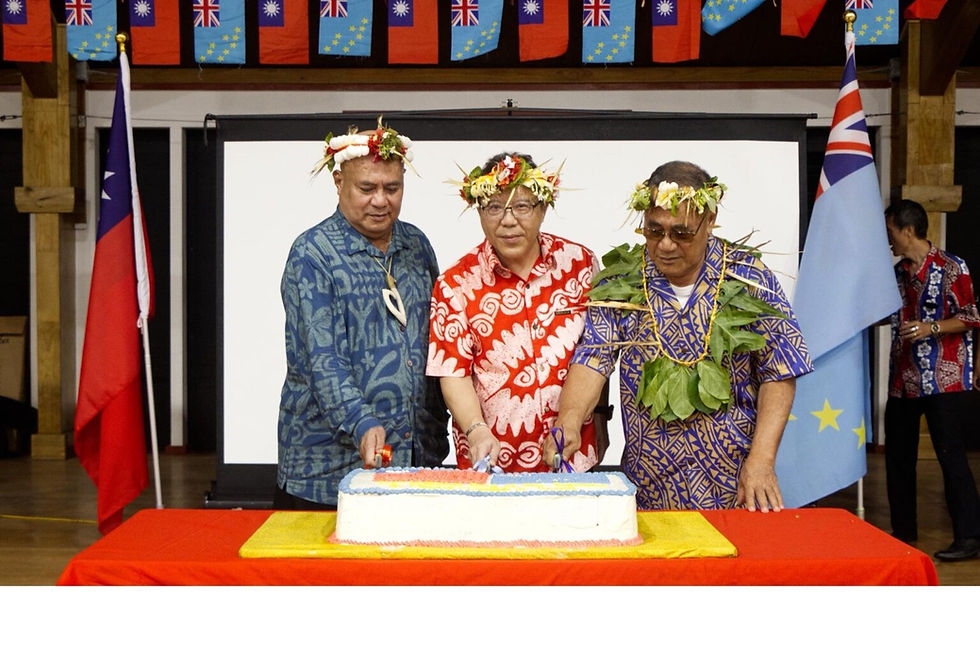Renewable Energy’s a new part of Yap’s landscape
- By Joyce McClure
- Nov 2, 2017
- 4 min read

Colonia-- The wind turbines seemed to appear on the hill above Colonia overnight. For several months, they lay flat on the ground, blades and shaft parallel, next to the Yap State Power Services buildings outside of town. They looked like missiles. Now they were standing upright, the blades slowly turning. People stopped and pointed at the most visible result of a nearly five-year long process to reduce the island’s dependence on fossil fuel.
The Yap Renewable Energy Development Project began when the Asia Development Bank awarded two loans to the Yap State Government totaling $9.1 million in 2013 for projects that would reduce fossil fuel consumption and stabilize electricity tariffs during spikes in global market fossil fuel costs. The government was required to provide counterpart funds of over $2.1 million and was, in turn, required to lend the loan proceeds to Yap State Public Service Corporation, the project implementer.
Renewable technology was to be employed and included the construction of a 1.4kW wind farm, installation of 300kW grid-connected solar power, and a high-speed, 1.8megawatt diesel generator. An integration and control system was planned to manage the integrated system and provide capacity building for the power company and the island’s communities.

The wind and solar power generation systems were projected to have a net reduction effect of over 22 percent of energy delivery in Yap, contributing to the FSM National Energy Policy objective of reducing dependence on fossil fuel by 30 percent and increasing energy efficiency by 50 percent by 2020.
Australian consulting firms Entura and CAT Energy Power Systems and Myanmar’s Sunlabob were hired by YPSCS and planning began.
The diesel generators and switchgear were successfully installed, certified and completed in May 2017, joining another generator that was concurrently installed and commissioned under a World Bank project. They now provide the primary source of generation with the old generators either offline for repair or used for reserve capacity.
Five government buildings were identified for PV solar systems and installations were completed on four with a total capacity of 114kW. As of June, the average monthly performance of those installations is between 69 and 72 percent capacity. Following delays due to roof renovation, the installation on the fifth building, the Yap Sports Complex gym, was due for completion in September 2017 and will provide the remaining 186kW.
But it wasn’t all that easy for the wind turbines up there on the hill due to land tenure and history.
Wa’ab Construction Company, a local firm, was contracted to do the earthworks at the wind farm site. Access roads required cutting trees, vegetation and crops. Due to restrictions based on the private ownership of land in Yap, meetings were held with village leaders and the landowners. Compensation was awarded to each landowner in the amount of $750 for tree and crop cutting and they each entered into a 20-year land lease, with a renewal option for another 20-year term. Rent payments of $25,000 per year will net the landowners a total of $500,000, the equivalent valuation of the land, over the first two decades. Work at the wind farm site began in May 2017 with monitoring by the Environmental Protection Agency and the Historic Preservation Office.
Relics of a long past war also got in the way. Yap was the site of air battles during World War II, when Japanese and U.S. bombers fought during the final year of the war. The wreckage of numerous planes has been saved and made into memorials that are maintained by the Yap Visitors Bureau. Ordnance has also been found over the years and now more likely live ordnance was uncovered on the hill that would be the site of the turbines. Old Japanese foxholes were discovered, as well. Work stopped and the site was closed to the public while inspections were conducted in June to take GPS locations and map the historic properties, identify access paths, and gather information for site development planning. A munitions crew arrived in September to safely remove the ordnance.
Due diligence determined that only .825kW out of the original wind goal of 1.4kW could be accommodated due to site restrictions posed by earthworks constraints and the preservation requirements for the newly uncovered WW II historic properties. Installation proceeded with these new requirements in place. A task force comprised of representatives of the community, the Executing Agency, Department of Land Resources, HPO, YVB and EPA has been formed to prepare a plan for the development of the historic properties on and around the wind farm as a tourism product. Their goal is protection and accessibility for tourists, maintenance of the sites, collection of visit fees, and the apportionment of fees for the landowners, as well as community benefits, site maintenance and tour guides’ training and compensation.
Yap is not only known for its stone money, but for the ancient stone paths that crisscross the island. Hikers who walk the stone path up the hill toward the wind farm will now be met with the convergence of the old and the new that defines the character and culture of the 7,000 people who live with one foot proudly planted in their ancient way of life and the other foot straddling new technology that will continue to benefit Yap’s future generations.
Joyce McClure is a freelance writer, photographer and marketing consultant who moved to Yap from New York City in August 2016 as a Peace Corps Response Volunteer. At the end of her service, she opted to remain in Yap to continue working with the Yap Visitors Bureau, 2018 MicroGames and Chamber of Commerce. Her writing and photos have appeared in the New York Times, National Geographic Traveler, Verge, GoWorldTravel.com and many other publications.





